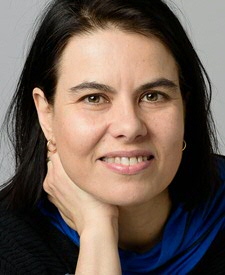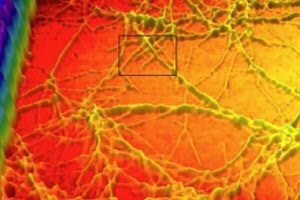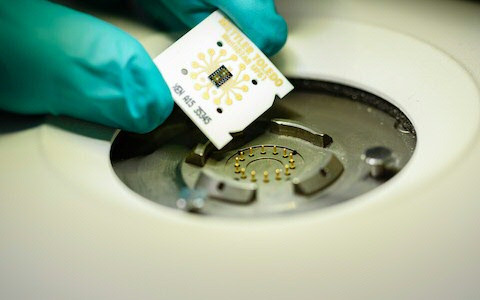CogniGron is two years along the path towards ‘human’ computers

The computer: our traditional powerful machine is rapidly approaching its limits, so researchers at the UG’s CogniGron centre are working on developing the computer of the future. Two years into the project, Beatriz Noheda, director of CogniGron, takes stock. Although developing a new super-calculator is obviously a long-term project, CogniGron has already achieved a lot.
Text: Eelco Salverda, Communication UG
The computer of the future: it has almost become a holy grail that is being sought by researchers from every corner of the earth. Beatriz Noheda, Professor of Functional Nanomaterials at the UG, and her colleagues from the fields of materials science, physics, mathematics, computer science and artificial intelligence are working on new materials for the next generation of computers, inspired by the functioning of the human brain. The current generation is approaching the limits of its capacities. ‘We need to change the way in which computers work if we are to keep up with the enormous amounts of data that are generated by the digital world,’ explains Noheda. ‘They cannot deal with big data efficiently, and they waste a lot of energy by doing so, forcing us to decide which data to process. This can and must become a more sustainable process, so that all of the useful information that is contained in the available data can be retrieved.’
Unused data
Noheda gives a few examples of data that currently goes unused. ‘Take medical data. An analysis of symptoms reported by patients from all around the world could help to prevent diseases. And merging worldwide seismographic data could generate insight into potential earthquakes. Or take ‘the internet of things’. We have been talking about fridges that tell the supermarket when you run out of milk for ten years now. These developments have ground to a halt because with the current computer design we are unable to process all of this data.’ But this could be very different. Computers may be better chess players than humans, but there are still things that humans do better.
The brain is an example
Current computers send every bit of information from transistor to transistor, one step at a time. The human brain, however, is able to process lots of information simultaneously. This is called parallel processing. ‘Take this room,’ says Noheda to illustrate. ‘If we sit here, you immediately know what to focus on. You listen to me and you don’t pay attention to, or in other words waste energy on, information regarding the carpet and the chairs, for instance, despite that this information is also being sent to your brain. We can prioritize in a millisecond. This is because the neurons, our brain cells, have thousands of mutual connections and form networks that can transport the information through a multitude of paths. Brain cells process information, but at the same time they are also able to store information as being a memory. Computers use two separate systems to perform these two tasks. This makes our brain highly economical in terms of energy. A computer that works like this would be a real game changer.’ Scientific coordinator Jasper van der Velde, who has now joined us, sums it up nicely: ‘To take some of the pressure off humans, we created something that did not resemble a human. We are now going back to the drawing board, and using humans as our model.’

The search for the perfect material
We need new materials, electronic circuits and systems to be able to imitate the function and connectivity of neurons. It’s not quite like looking for the proverbial needle in a haystack, but it certainly isn’t easy. ‘We have six research groups working at the Zernike Institute for Advanced Materials, each of which is studying two or three potentially suitable materials,’ explains Noheda. ‘The material we are looking for must satisfy a lot of conditions – and you also have to take long-term availability into account.’
Unique collaboration
‘We soon realized that researchers from a single field wouldn’t be able to do everything that we wanted to do,’ Noheda continues. Whereas much of the research into new computers is carried out from within one single scientific discipline, the UG entered into a unique collaboration between the materials scientists from the Zernike Institute and the Bernoulli Institute for Mathematics, Computer Science and Artificial Intelligence. ‘The computer scientists tell us exactly what is needed. The mathematicians make models of the properties, which the physicists then test on the new materials in their labs. Artificial intelligence researchers explain what the new hardware must be capable of. Algorithms developed within the field of Artificial Intelligence have proven to broaden our horizons, but the current generation of computers simply can’t deal with them.’ What was once a modern, useful machine is rapidly becoming the limiting factor.
Two productive years
CogniGron has existed for two-and-a-half years now. How are things going? ‘Really well,’ Noheda continues. ‘Over thirty professors are now working on CogniGron related projects. We managed to recruit ten new professors. They were very keen to join us because they are equally enthusiastic about our vision and goals. In turn, CogniGron benefits from their expertise and global contacts. They are knowledge magnets.’ And then there's the newly acquired transmission electron microscope (TEM), another flagship. There are only about ten of these microscopes in the whole world, and they can be used to study materials at the atomic level. ‘That is a very important factor,’ Van der Velde stresses. ‘You have to know exactly how a material works before you can control it and make it work for you.’ Finally, CogniGron has published around ten important articles in leading professional journals.
Text continues below the video
Learning to understand each other
Noheda explains that much of the initial years was spent generating understanding and trust. ‘A collaboration between four disciplines requires a lot of brainstorming and discussions. What are we doing, how can we help each other? Only this way we can effectively combine the strengths of each discipline.’ Noheda and her colleagues are based in Nijenborgh 4, which is the physics and chemistry building. One building further, you’ll find the computer scientists, the mathematicians and the artificial intelligence researchers. They are only a few physical steps apart, but the metaphorical distance can be more difficult to span. ‘Every discipline has its own way of working. People think differently,’ explains Van der Velde. ‘You have to learn each other's language.’ But they managed. A shared vision and joint goal have helped to tear down walls and remove barriers. ‘Sharing experiences helps you to grow,’ says Noheda. ‘It’s healthy to look at things from the other side every now and then,’ she laughs.
New generation of scientists
Working together means stepping out of your comfort zone. This can be a challenging, time-consuming business. Not everyone is flexible enough. All newly appointed professors therefore work in more than one field; they feel comfortable in two different worlds. In this respect, Noheda has high expectations of the PhD students working at CogniGron, where they grow up in a multidisciplinary environment. ‘We are already seeing this with some of our Bachelor’s and Master’s students. They prefer broader-based course units, such as maths and physics, or physics and computer science. CogniGron is exactly what I was looking for, you hear them say.’
Text continues below the photo

Experimenting
Fundamental research but with a practical goal – would that be a good description of Noheda’s work? ‘Yes, indeed,’ she nods, ‘because that computer is still a long way off. No, that’s not frustrating. It’s all about the ongoing learning process. We saw that we were getting closer after just six months. We’re happy with every step in the right direction.’ HP, IBM, Intel; they are all following CogniGron with great interest. These are the companies that will ultimately be manufacturing the computers. ‘We work closely with companies like these but they can’t diversify in their research as much as we can. Companies need to sell products and earn money. Researchers can be more adventurous, and try bolder ideas.’ She is echoing Nobel Prizewinner Ben Feringa’s words: ‘Let universities be playgrounds’. ‘Our mindset is broader,’ adds Van der Velde. ‘Some materials work best at extreme temperatures. A company won’t investigate this, as the temperature would be too high for commercial purposes. So that’s what we do. And if a material turns out to work, we start looking for workability at a more feasible temperature.’
Trendsetter
The multidisciplinary character of CogniGron also has a disadvantage. Research findings take longer to generate and are more difficult to publish as they fall outside the scope of field-specific scientific journals. But this hurdle is also being cleared. A new journal recently appeared: Neuromorphic computing and engineering. Three CogniGron researchers are closely involved in this journal, which just goes to show how things in academia are changing. And maybe how much of a trendsetter CogniGron is.
The future
CogniGron got off the ground two years ago thanks to the promise of a very generous donation. The size of this donation only became clear last Monday. An anonymous former student of the UG has donated a sum of € 30 million to the centre. Knowing the exact amount has opened new doors. Noheda is already dreaming about the future. ‘We need to use these funds to generate more funds to maintain GogniGron alive in the future. We would like to broaden the scope of the project. Computers ultimately impact society, people and their behaviour, so we are keen to get neuroscientists, social scientists, IT lawyers, philosophers and ethicists involved. A new computer concept means a new society.’
